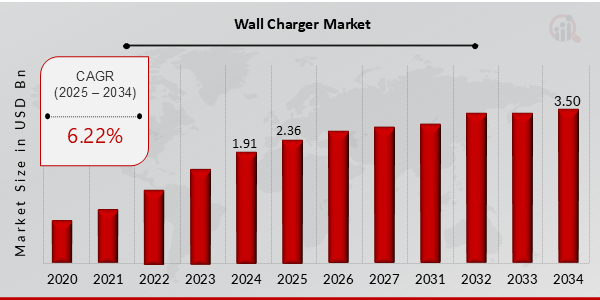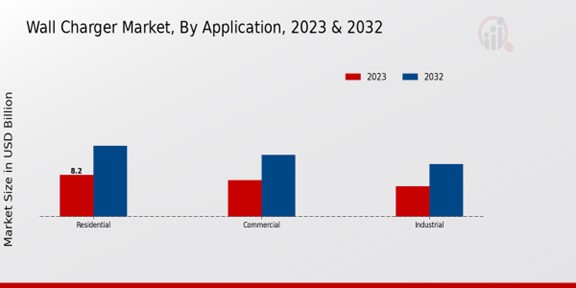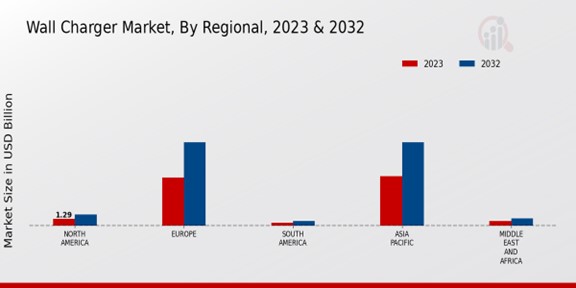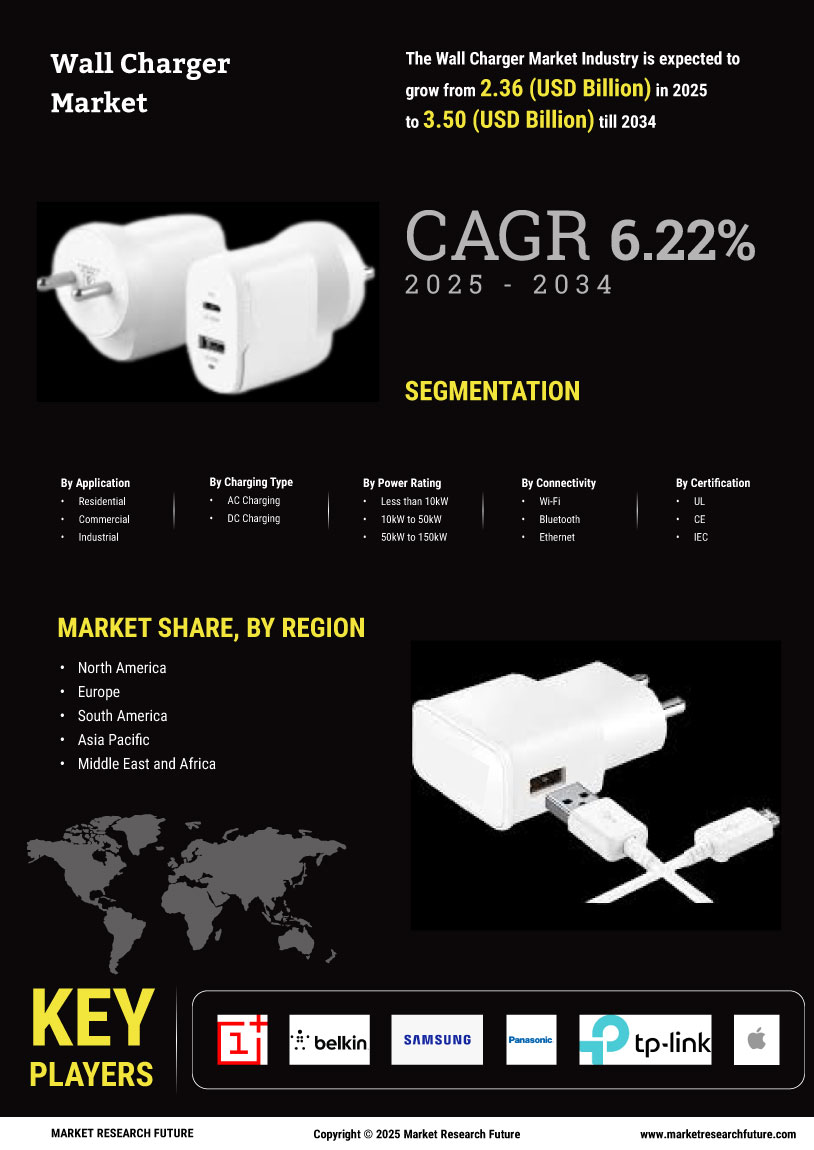Global Wall Charger Market Overview
Wall Charger Market Size was estimated at 1.91 (USD Billion) in 2024. The Wall Charger Market Industry is expected to grow from 2.36 (USD Billion) in 2025 to 3.50 (USD Billion) till 2034, exhibiting a compound annual growth rate (CAGR) of 6.22% during the forecast period (2025 - 2034).
Key Wall Charger Market Trends Highlighted
The Global Wall Charger Market is experiencing rapid growth driven by the surging demand for smartphones and other mobile devices. The proliferation of high-powered devices and the increasing adoption of fast-charging technologies are further fueling market expansion. Technological advancements, such as the advent of wireless and multi-port chargers, are creating new opportunities for innovation and differentiation. Opportunities lie in the development of energy-efficient and sustainable charging solutions, leveraging advanced materials and designs to optimize power consumption. The integration of smart features, such as AI-powered charging optimization and remote monitoring capabilities, is also expected to drive market growth. Additionally, the increasing use of wearable devices and electric vehicles is creating additional demand for compact and versatile wall chargers.
Recent market trends indicate a shift towards portable and compact chargers with multiple ports to accommodate different devices. The integration of advanced technologies, such as Gallium Nitride (GaN) semiconductors, is enabling the development of smaller and more efficient chargers. Furthermore, the growing popularity of USB Type-C connectors is driving the adoption of universal charging solutions that support a wider range of devices.

Source: Primary Research, Secondary Research, MRFR Database and Analyst Review
Wall Charger Market Drivers
Increased Demand for Electric Vehicles (EVs)
The growing popularity of electric vehicles (EVs) is a primary driver of the global Wall Charger Market Industry. As more consumers opt for eco-friendly transportation, the demand for convenient and efficient charging solutions increases. Wall chargers offer a safe and reliable way to charge EVs at home or in public spaces, making them an essential component of the EV infrastructure. The rise in EV sales is expected to continue in the coming years, further propelling the growth of the Wall Charger Market Industry.
Technological Advancements
The Wall Charger Market Industry is constantly evolving, with technological advancements playing a crucial role. Manufacturers are introducing chargers with faster charging capabilities, smaller sizes, and enhanced features. The integration of smart technology enables remote monitoring, scheduling, and energy optimization, improving the user experience and efficiency. Moreover, the development of wireless charging solutions is gaining traction, offering the convenience of charging without the need for physical connections.
Government Initiatives and Regulations
Government initiatives and regulations play a significant role in shaping the Wall Charger Market Industry. Many countries are implementing policies to promote the adoption of EVs and reduce carbon emissions. These policies often include incentives for installing EV charging infrastructure, such as tax credits or rebates. Furthermore, governments are setting regulations to ensure the safety and standardization of charging systems, which creates opportunities for manufacturers to develop compliant products.
Wall Charger Market Segment Insights:
Wall Charger Market Application Insights
The Global Wall Charger Market segmentation by Application is categorized into Residential, Commercial, and Industrial. Among these, the residential segment is anticipated to dominate the market growth owing to the increasing adoption of smart devices and the growing demand for convenient charging solutions. The rising consumer preference for fast charging capabilities and the widespread adoption of smartphones, tablets, and laptops contribute to the segment's dominance. As per market research, the residential segment is projected to account for approximately 55% of the Global Wall Charger Market revenue in 2024, valued at around USD 12.1 billion. The commercial segment is expected to witness steady growth, driven by the increasing demand from offices, retail stores, and public spaces.
The growing number of commercial establishments and the need for efficient charging solutions for employees and customers are key factors supporting the segment's expansion. The market data suggests that the commercial segment is estimated to hold a market share of around 30% in 2024, with a valuation of approximately USD 6.6 billion. The industrial segment is anticipated to experience moderate growth, primarily driven by the demand from manufacturing facilities, warehouses, and transportation hubs. The increasing adoption of automation and the need for reliable charging solutions for industrial equipment and machinery contribute to the segment's growth. The Global Wall Charger Market statistics indicate that the industrial segment is projected to account for approximately 15% of the market revenue in 2024, valued at around USD 3.3 billion.

Source: Primary Research, Secondary Research, MRFR Database and Analyst Review
Wall Charger Market Charging Type Insights
AC Charging segment held a market share of 55.7% in 2023. AC Charging is more common in residential and commercial applications due to the wide availability of AC power outlets. DC Charging segment is expected to witness higher growth over the forecast period due to the increasing popularity of electric vehicles (EVs) and the need for faster charging times.
Wall Charger Market Power Rating Insights
Power rating is a key segmentation factor in the Wall Charger Market, with different power ratings catering to specific charging needs. Power Rating Segment Insights: Less than 10kW: Chargers with power ratings below 10kW are commonly used for charging low-power devices such as smartphones, tablets, and laptops. This segment holds a significant market share due to the widespread adoption of these devices. 10kW to 50kW: Chargers in this range are suitable for charging electric vehicles (EVs). With the increasing adoption of EVs, this segment is projected to witness significant growth in the coming years. 50kW to 150kW: These chargers are primarily used for fast-charging EVs. They offer faster charging times compared to lower-power chargers, making them ideal for commercial and public charging stations. Over 150kW: Chargers exceeding 150kW are ultra-fast chargers designed for rapid charging of EVs. They are expected to gain traction as battery technology improves, and demand for faster charging solutions increases.
Wall Charger Market Connectivity Insights
The Connectivity segment of the Global Wall Charger Market is anticipated to exhibit robust growth in the coming years, driven by the increasing adoption of smart devices and the growing popularity of wireless charging technologies. Wi-Fi connectivity is expected to account for a significant share of the segment, owing to its widespread availability and ease of use. Bluetooth connectivity is also gaining traction, especially for short-range wireless connections between devices. Ethernet connectivity offers high-speed wired connections, making it suitable for applications requiring fast data transfer rates. Mobile App connectivity allows users to control and monitor their wall chargers remotely, providing added convenience and functionality. The Global Wall Charger Market segmentation provides valuable insights into the different connectivity options available, enabling manufacturers to develop products that meet the evolving needs of consumers.
Wall Charger Market Certification Insights
The Certification segment plays a crucial role in the Global Wall Charger Market. Certifications like UL, CE, IEC, and NEMA ensure that wall chargers adhere to safety and quality standards, which is essential for consumer confidence and regulatory compliance. The growing emphasis on safety and the proliferation of counterfeit products are driving the demand for certified wall chargers. In 2023, the UL certification held the largest market share, with a significant revenue contribution. CE certification is expected to witness substantial growth due to increasing demand from the European Union and other regions adopting CE standards.IEC and NEMA certifications are also gaining traction, driven by the need for international compliance and the growing popularity of smart home devices. The rising adoption of these certifications is expected to contribute to the overall growth of the Global Wall Charger Market in the coming years.
Wall Charger Market Regional Insights
The market is driven by the increasing demand for smartphones, tablets, and other portable devices. Regionally, North America is expected to hold the largest market share, followed by Europe, APAC, South America, and MEA. North America is the largest regional market for wall chargers, accounting for over 35% of the global market in 2023. The region is home to a large number of smartphone and tablet users, as well as a well-developed infrastructure for charging devices. Europe is the second-largest regional market for wall chargers, with a market share of over 25%. The region has a high adoption rate of smartphones and tablets and a growing demand for wireless charging devices. APAC is the third-largest regional market for wall chargers, with a market share of over 20%. The region is expected to see significant growth in the coming years due to the increasing adoption of smartphones and tablets in emerging economies such as China and India. South America and MEA are the two smallest regional markets for wall chargers, with market shares of 10% and 5%, respectively. However, these regions are expected to see strong growth in the coming years due to the increasing adoption of smartphones and tablets.

Source: Primary Research, Secondary Research, MRFR Database and Analyst Review
Wall Charger Market Key Players And Competitive Insights:
Major players in the Wall Charger Market industry are continuously striving to gain a competitive edge by launching innovative products and expanding their geographical reach. Leading Wall Charger Market players are investing heavily in research and development to enhance the efficiency and functionality of their products. The Wall Charger Market Competitive Landscape is characterized by intense competition, with key players such as Anker, Samsung, Apple, and Belkin vying for market share. These companies are adopting strategies such as collaborations, partnerships, and acquisitions to strengthen their position in the industry and drive Wall Charger Market development. Anker, a leading provider of charging solutions, has established a strong presence in the Wall Charger Market through its innovative products and strategic partnerships. The company's extensive portfolio includes a range of wall chargers designed to meet the diverse needs of consumers. Samsung, a global electronics giant, leverages its brand recognition and technological expertise to compete effectively in the Wall Charger Market.
The company offers a wide variety of wall chargers that are compatible with its mobile devices and other electronic products. Apple, known for its premium products, caters to the high-end segment of the Wall Charger Market. The company's wall chargers are designed to complement its iPhones and other Apple devices, offering fast and reliable charging capabilities. Belkin, a renowned provider of connectivity solutions, has gained a significant market presence through its innovative and reliable wall chargers. The company's focus on quality and durability has earned it a loyal customer base. Belkin offers a wide range of wall chargers that cater to different consumer needs and preferences, including fast-charging options and multi-port chargers. These key players, along with other notable competitors, are shaping the competitive dynamics of the Global Wall Charger Market.
Key Companies in the Wall Charger Market Include:
- OnePlus
- Belkin
- Samsung
- Panasonic
- TPLink
- Apple
- Anker Innovations
- Oppo
- Xiaomi
- Vivo
- Toshiba
- Sony
- LG
- Realme
- Huawei
Wall Charger Industry Developments
The global Wall Charger Market is projected to reach a valuation of USD 36.44 billion by 2032, expanding at a CAGR of 6.07% from 2024 to 2032. The market growth is attributed to the increasing adoption of smartphones, tablets, and other portable devices, coupled with the rising demand for fast and efficient charging solutions. Furthermore, the growing popularity of electric vehicles is expected to drive demand for wall chargers designed specifically for EV charging. Technological advancements, such as the development of gallium nitride (GaN) chargers, are also contributing to market growth due to their ability to provide faster charging speeds and improved efficiency. Additionally, government initiatives and regulations aimed at promoting the adoption of electric vehicles are expected to provide further impetus to the market.
Wall Charger Market Segmentation Insights
Wall Charger Market Application Outlook
- Residential
- Commercial
- Industrial
Wall Charger Market Charging Type Outlook
Wall Charger Market Power Rating Outlook
- Less than 10kW
- 10kW to 50kW
- 50kW to 150kW
- Over 150kW
Wall Charger Market Connectivity Outlook
- Wi-Fi
- Bluetooth
- Ethernet
- Mobile App
Wall Charger Market Certification Outlook
Wall Charger Market Regional Outlook
-
North America
-
Europe
-
South America
-
Asia Pacific
-
Middle East and Africa
|
Report Attribute/Metric
|
Details
|
|
Market Size 2024
|
USD 1.91 Billion
|
|
Market Size 2025
|
USD 2.36 Billion
|
|
Market Size 2034
|
USD 3.50 Billion
|
|
Compound Annual Growth Rate (CAGR)
|
6.22% (2025-2034)
|
|
Base Year
|
2024
|
|
Market Forecast Period
|
2025-2034
|
|
Historical Data
|
2020-2023
|
| Market Forecast Units |
USD Billion |
| Key Companies Profiled |
OnePlus, Belkin, Samsung, Panasonic, TPLink, Apple, Anker Innovations, Oppo, Xiaomi, Vivo, Toshiba, Sony, LG, Realme, Huawei |
| Segments Covered |
Application, Charging Type, Power Rating, Connectivity, Certification, Regional |
| Key Market Opportunities |
USBC Power Delivery PD Rapid charging and universal compatibility.Wireless Charging Integration Convenience and ubiquitous charging options.Smart Charging Features Energy optimization and personalized charging.Increased Demand for GaN Chargers Compact efficient and high-power charging Sustainability and Eco Consciousness Energy-efficient and recyclable materials |
| Key Market Dynamics |
Rising demand for fast-charging Technological advancements Increasing penetration of smartphones Need for portable charging solutions Growing awareness of energy efficiency |
| Countries Covered |
North America, Europe, APAC, South America, MEA |
Frequently Asked Questions (FAQ) :
The Global Wall Charger Market is expected to reach a valuation of USD 1.91 Billion in 2024 and is projected to grow at a CAGR of 6.22% from 2025 to 2034, reaching a total market size of USD 3.50 Billion by 2034.
North America region is expected to dominate the Global Wall Charger Market, with a market share of 45.0% in 2023. North America and Europe are also significant markets for wall chargers, with market shares of 20.1% and 18.5%, respectively. The Middle East and Africa, and Latin America are expected to experience steady growth in the coming years.
Wall chargers are primarily used for charging smartphones, tablets, and other mobile devices. They are also used in various other applications, such as charging laptops, power banks, and other electronic devices.
The major players in the Global Wall Charger Market include Anker, Belkin, Samsung, Apple, Sony, Xiaomi, Huawei, and Panasonic.
The growth of the Global Wall Charger Market is driven by several key trends, including the increasing adoption of smartphones and other mobile devices, the growing demand for faster charging solutions, and the advancements in power semiconductor technology.
The Global Wall Charger Market faces several challenges, such as the intense competition from low-cost manufacturers, the stringent regulatory requirements, and the environmental concerns associated with the disposal of electronic waste.
The future outlook for the Global Wall Charger Market is positive. The market is expected to continue to grow at a steady pace, driven by the increasing demand for mobile devices and the advancements in charging technology.
The key growth opportunities for the Global Wall Charger Market include the development of new charging technologies, the expansion into emerging markets, and the development of innovative applications for wall chargers.
The growth of the Global Wall Charger Market in the Asia Pacific region is driven by several key factors, including the increasing adoption of smartphones and other mobile devices, the growing demand for faster charging solutions, and the presence of a large number of low-cost manufacturers.
The growth of the Global Wall Charger Market in the North American region is driven by several major trends, including the increasing adoption of wireless charging technology, the growing demand for faster charging solutions, and the presence of a large number of technology companies.

















